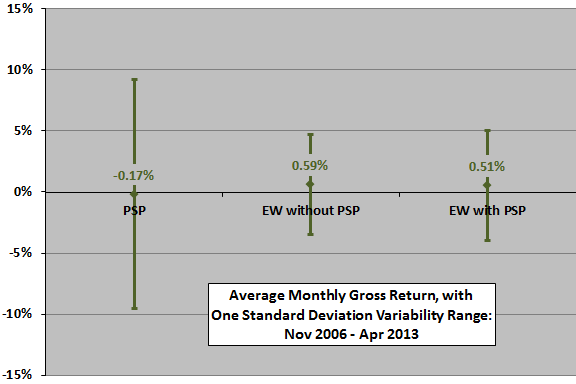Does adding a proxy for private equity to a diversified portfolio improve its performance? To check, we add PowerShares Global Listed Private Equity (PSP) to the following mix of asset class proxies (the same used in “Simple Asset Class ETF Momentum Strategy”):
PowerShares DB Commodity Index Tracking (DBC)
iShares MSCI Emerging Markets Index (EEM)
iShares MSCI EAFE Index (EFA)
SPDR Gold Shares (GLD)
iShares Russell 1000 Index (IWB)
iShares Russell 2000 Index (IWM)
SPDR Dow Jones REIT (RWR)
iShares Barclays 20+ Year Treasury Bond (TLT)
3-month Treasury bills (Cash)
First, per the findings of “Asset Class Diversification Effectiveness Factors”, we measure the average monthly return for PSP and the average pairwise correlation of PSP monthly returns with the monthly returns of the above assets. Then, we compare cumulative returns and basic monthly return statistics for equally weighted (EW), monthly rebalanced portfolios with and without PSP. We ignore rebalancing frictions, which would be about the same for the alternative portfolios. Using adjusted monthly returns for PSP and the above nine asset class proxies from November 2006 (first return available for PSP) through April 2013 (78 monthly returns), we find that:
The following chart summarizes average monthly returns with variability ranges of one standard deviation for PSP and the EW portfolios without and with PSP over the available sample period. During this time, PSP generates a poor average return with high volatility. Adding PSP to the diversified EW portfolio reduces return and slightly elevates volatility. The ratio of average return to standard deviation (return per unit of risk) is 0.14 (0.11) without (with) a PSP position.
The average pairwise correlation of PSP monthly returns with those of the other assets is a relatively high 0.50 over the available sample period. Highest correlations are with equities and RWR.
Per “Asset Class Diversification Effectiveness Factors,” the poor average return (high average pairwise correlation) of PSP indicates a poor (poor) contribution with respect to portfolio diversification.
Sample size is not large in terms of number of months or variety of market conditions.
What is the net effect on cumulative portfolio performance?

The next chart compares cumulative values of EW portfolios without and with PSP in the mix over the available sample period. Adding PSP depresses cumulative return over the sample period.
Again, sample size is not large.

In summary, evidence from simple tests over the available sample period does not support belief that adding a proxy for private equity to a diversified portfolio improves overall performance.
Cautions regarding findings include:
- As noted, the sample period is not long in terms of market conditions.
- Including the trading frictions associated with monthly rebalancing would depress performance of both portfolios, depending mostly on portfolio size.